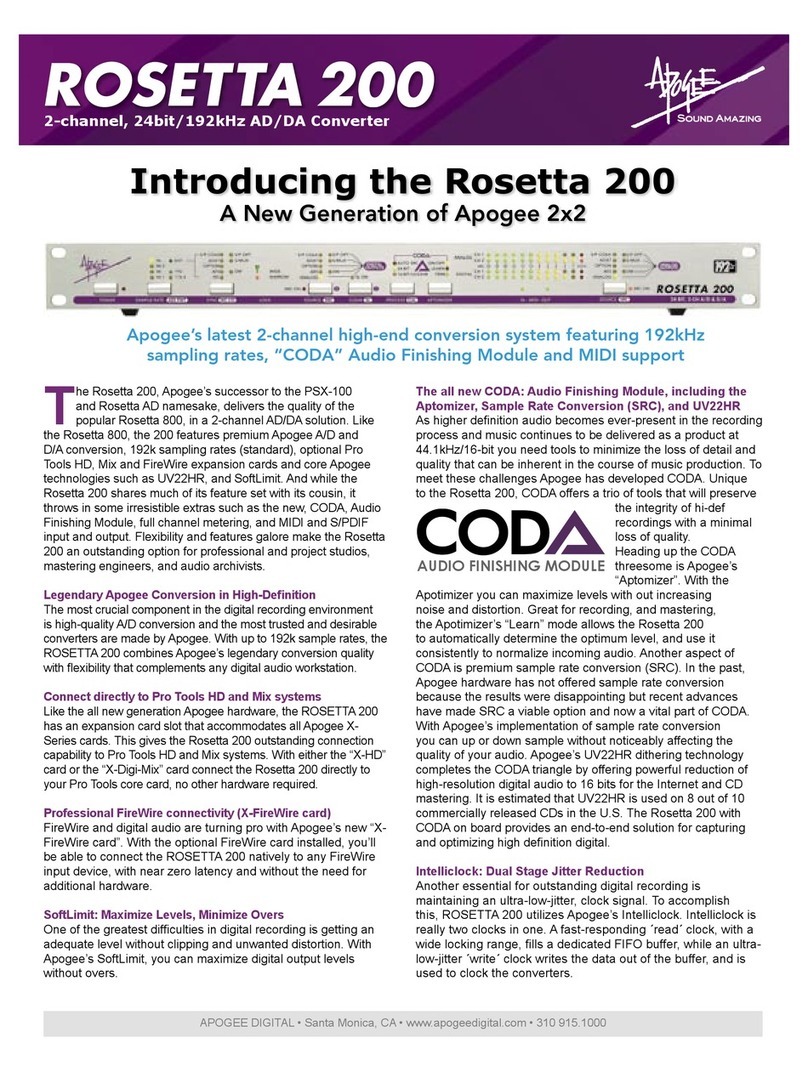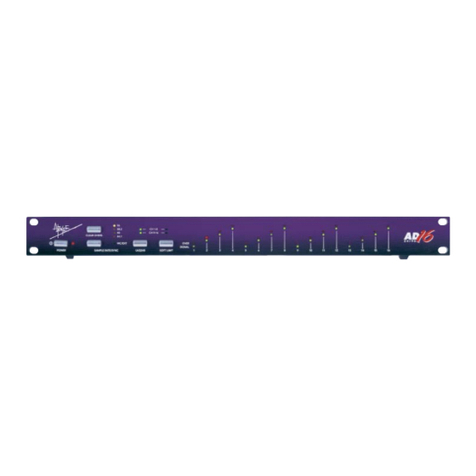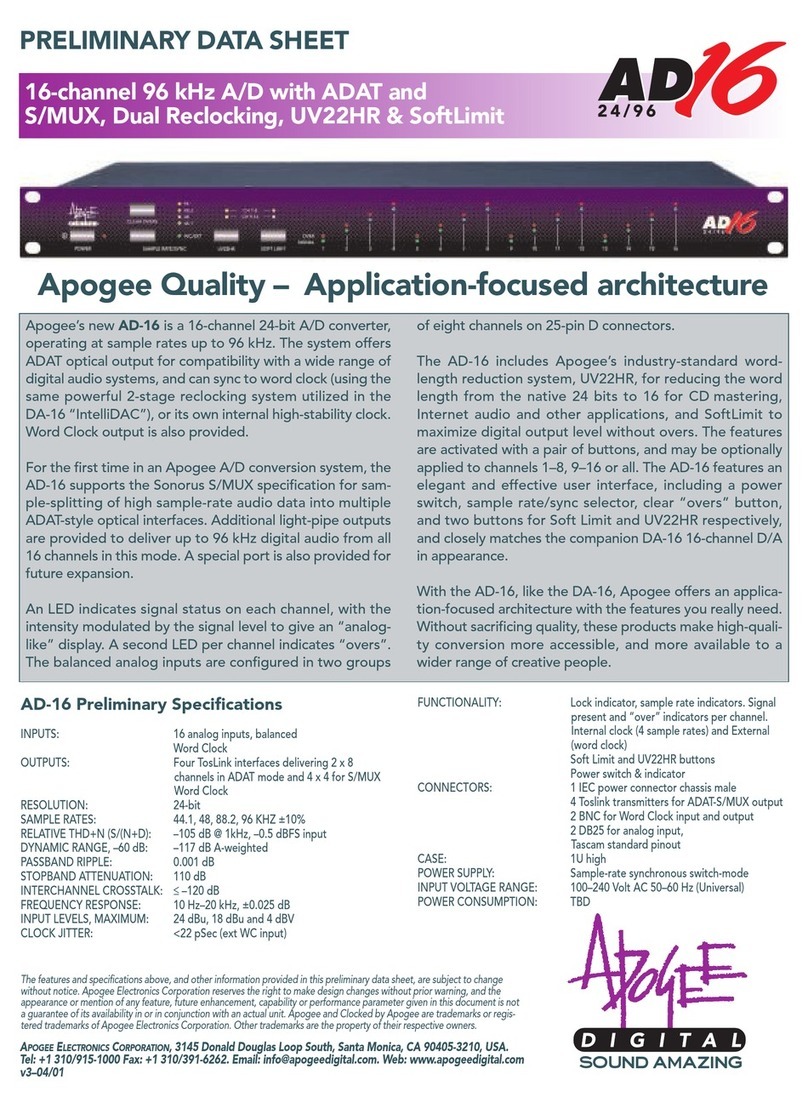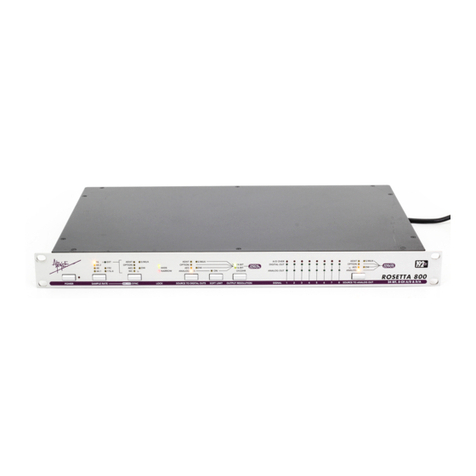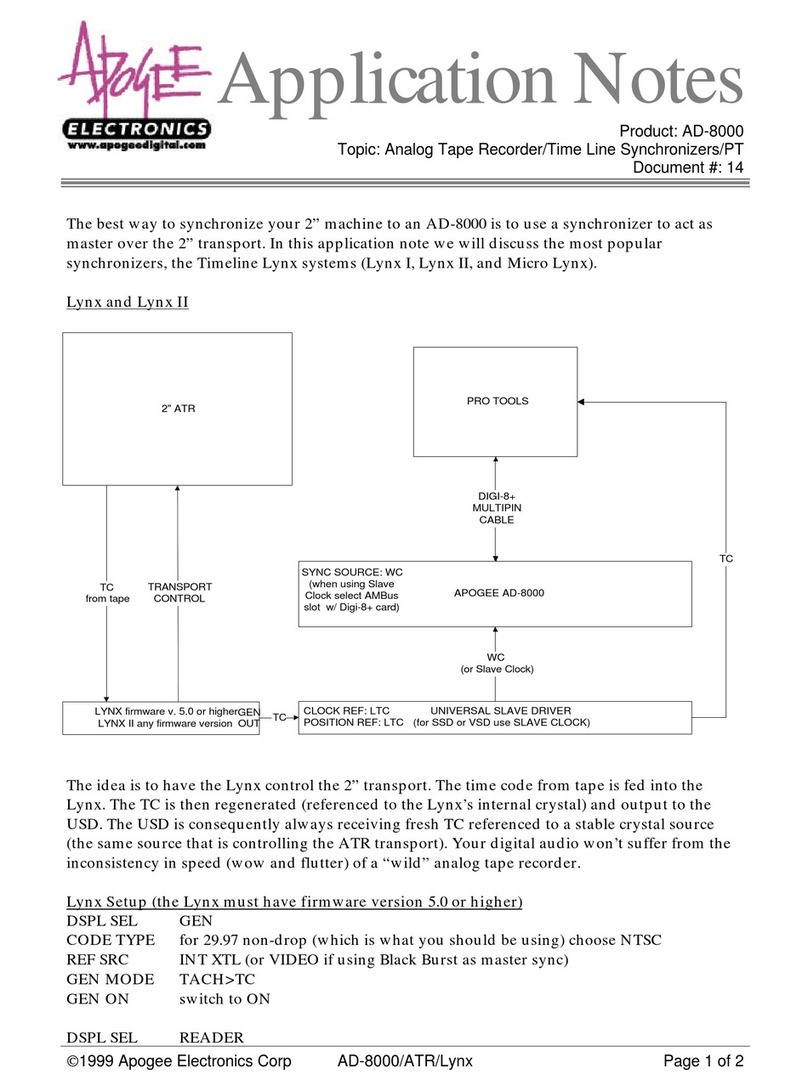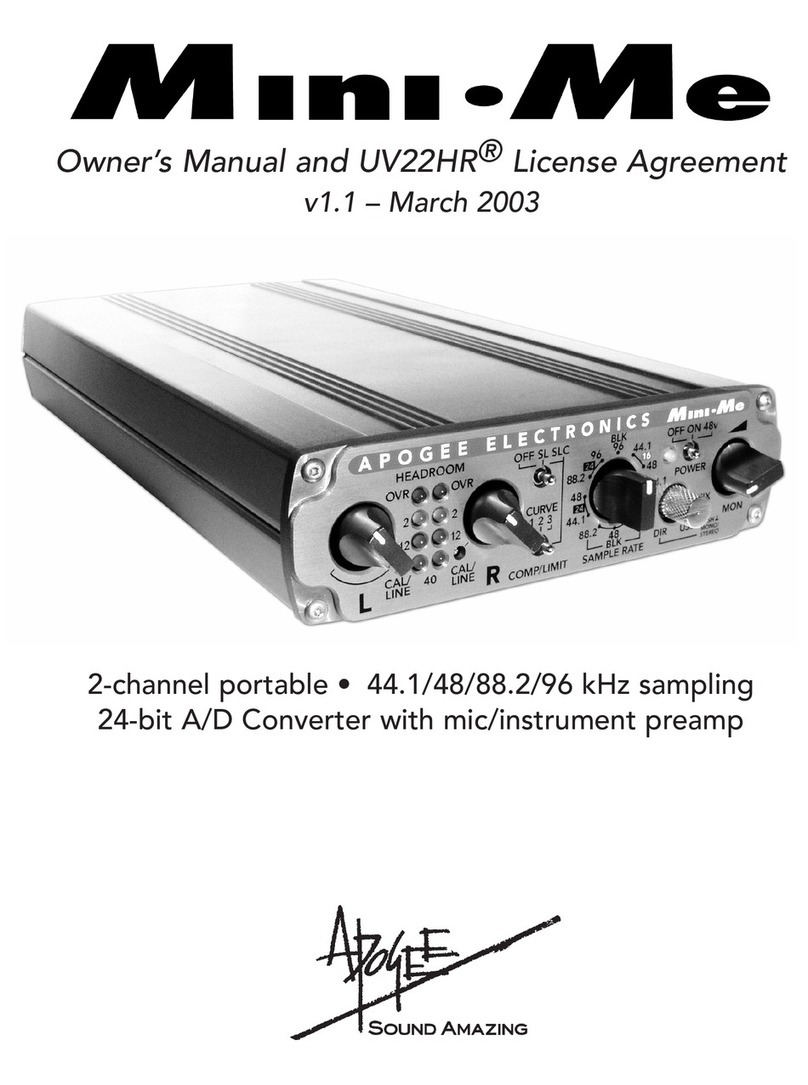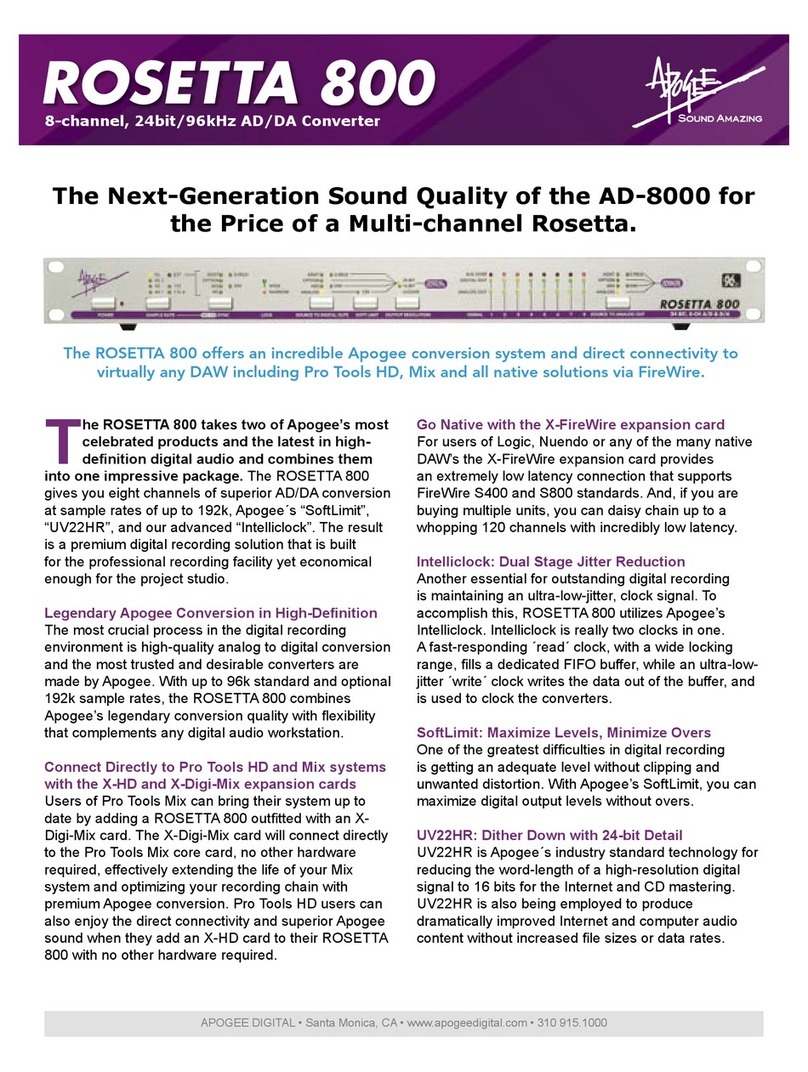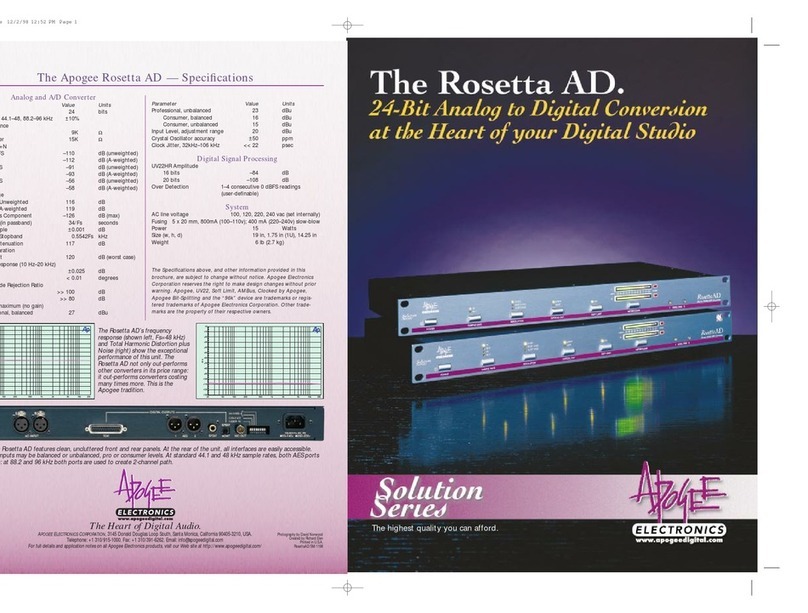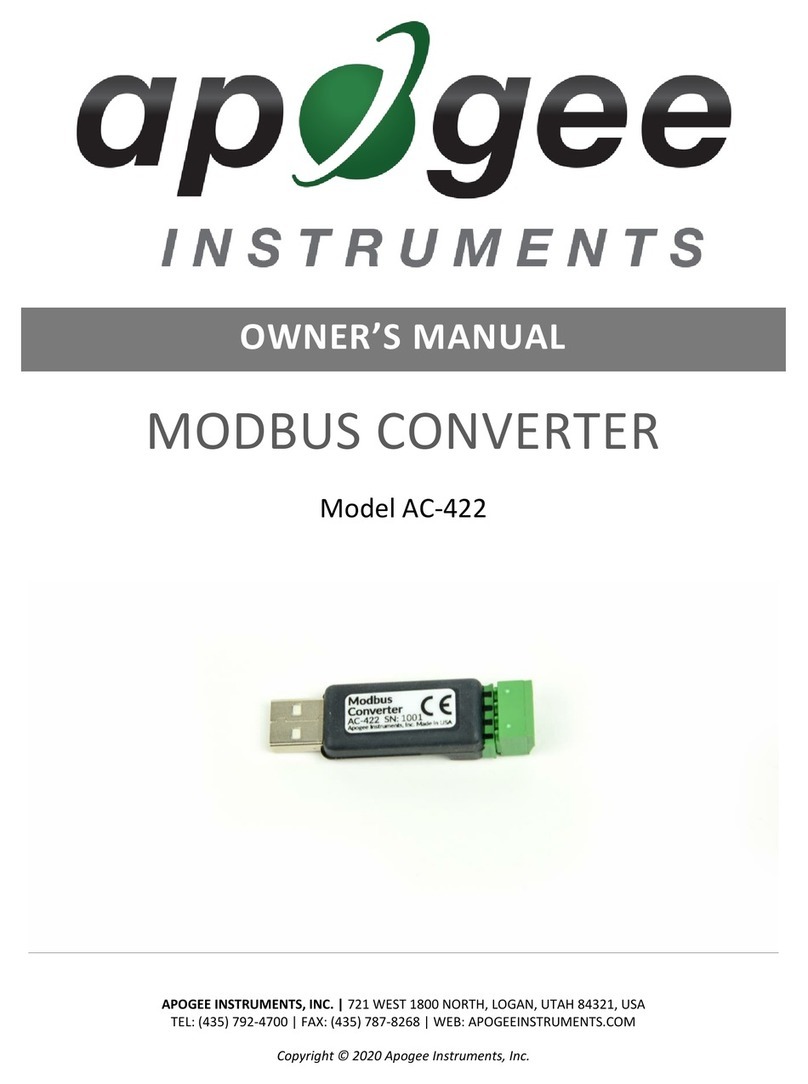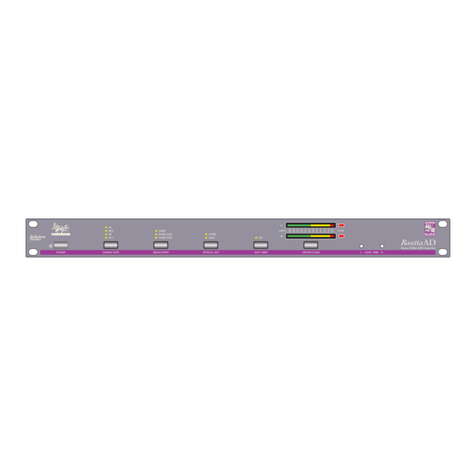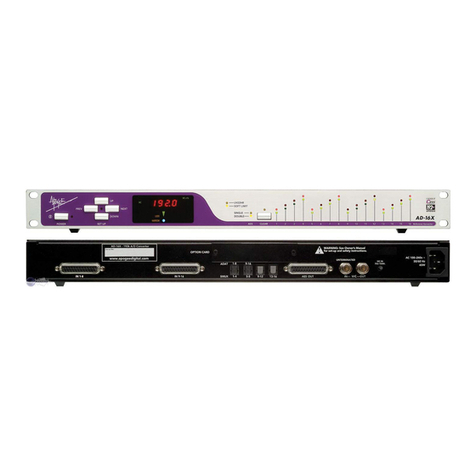…The 2-channel conversion solution. Apogee quality. At the Heart of Digital Audio.
Sample Rate & Sync Options: 44.1, 48,
88.2 and 96kHz sample rates make the PSX-
100 a star performer, locking to ultra-stable
crystal or external digital inputs or word
clock. An optional video sync card allows the
unit to lock to common video standards.
Advanced Metering System: The PSX-
100 includes easy-to-read light-bar metering,
including “over” indication with 2-second/infi-
nite hold. User-defined “over” setting (1-4 con-
secutive digital full-scale readings). Meter
either the A/D or D/A in “confidence mode”.
Calibration mode with ±0.1 dB setup accuracy.
MDM Input Selection: When using the
PSX-100 with modular digital multitracks,
select the pair of tracks you want to listen to
(or the set of tracks for replaying a bit-split
source).
24-bit, 96kHz A/D-D/A conversion:
The PSX-100 is Apogee’s first high resolution,
high sample-rate conversion system, featuring
true 24-bit conversion and impressive
technical specifications
(see back cover)
.
Minimal THD+Noise. Stunning dynamic range.
And a frequency response that’s flat all the
way across the band. And it’s an Apogee –
it sounds great!
Optical Output Selection: The built-in
optical interfaces support both S/PDIF and
ADAT protocols for maximum flexibility.
The PSX-100 2-channel, 96kHz, 24-bit converter.
The PSX-100 2-channel, 96kHz, 24-bit converter.
The PSX-100 consists of four main sections:
Digital Inputs, Digital Outputs, A/D Converter
and D/A Converter, plus additional functions
such as aux outputs, UV22HR and Soft Limit.
The way in which the main blocks are inter-
connected is determined by the current mode
of operation.
In Confidence Monitor mode, the A/D and
D/A are essentially separate, the D/A deriving
its input from the digital inputs and the A/D
driving all the main outputs.
Digital Copy takes the selected digital input
and delivers it to all the unit’s outputs, ana-
log and digital. Ideal for digital copying and
format conversion without repatching.
Analog Monitor mode takes the A/D output
and feeds it to all system outputs and to the
D/A, which therefore monitors the conversion
carried out in the A/D section.
Apogee quality. At the Heart of Digital Audio.
AES/EBU Auxiliary Output: The Aux
Out is a digital AES/EBU output providing a
“clean feed” from the system. It can act as an
additional parallel AES/EBU output for
distribution purposes, or it can be used to
record, for example, a full-resolution 24-bit
mix while the other outputs are delivering
16- or 20-bit feeds with UV22.
Main AES/EBU inputs: Two inputs are
provided and can be individually selected
from the front panel. (Both connectors are
used for 88.2/96 kHz operation.)
Linear Power Supply: AC input is inter-
nally selectable and fused for international
voltages. Power feeds a super-smooth linear
power supply built around a true toroidal
transformer, minimizing interference to either
analog or digital circuitry and avoiding poten-
tial spikes and noise. A generously-specified
exposed heat sink
(see cover)
effectively con-
trols the temperature of the unit.
TDIF Interface: A DB-25 connector
provides interfacing with TDIF devices such as
Tascam modular digital multitracks, consoles,
DAWs and digital audio PC cards which
feature this kind of interfacing.
S/PDIF Coaxial Input: An industry-
standard RCA connector provides S/PDIF
coaxial input capability.
*Apogee Bit-Splitting for 96 kHz:
Apogee’s new ABS-96 technique allows you to
use your existing 16-bit, 8-track, 44.1/48 kHz
MDM for stereo 96 kHz mastering, in addition
to the existing 4/24 “PaqRat” mode which
allows 24-bit signals to be recorded on pairs
of 16-bit tracks.
…The 2-channel conversion solution.
PSX-100 Functional
Block Diagram
A
POGEE ELECTRONICS
has a reputation for
producing the very best sounding
digital conversion products avail-
able. You might also think of us as
being quick off the mark. But in
fact, we think very carefully
before we release a new product.
That’s how it was when we
came to design our first 24-bit,
96kHz sampling-rate conversion
system: the PSX-100.
Anyone can make 24 bits dance
up and down 96,000 times a
second. The question is, does it
sound any better? In many cases,
the answer is no – and to our
engineers, there was no point
without a significant improve-
ment in the sound. So clock
circuitry had to be even more
rigorously designed to minimize
jitter. Analog components
required special characteristics to
realize the performance we
specified. And much more.
We wanted to give our first 96kHz system all the features
needed to make it truly indispensable. AES, S/PDIF, ADAT and
TDIF I/O for highest flexibility. Apogee Bit-Splitting for 24-bit,
96kHz mastering to 16-bit, 48kHz MDMs. UV22HR for flawless 16-
and 20-bit output. Soft Limit for maximum level without overs.
Digital copy, confidence and analog monitoring modes. Sync to
word clock and optional video.
The result: a total stereo conversion solution.
Fully indepen-
dent A/D and D/A converters in a single 1U package
.
Benefits of
Outboard
Conversion
The sole reason that Apogee
Electronics Corporation exists is
to make digital audio sound
better.
From the very beginning, we
knew that digital audio was by no
means free of problems: but we
were sure that those problems
could ultimately be solved.
The introduction of new, high
sample rates for DVD-Video and
DVD-Audio authoring and other
applications has made digital
audio more complex, and the
manufacture of high-quality, high-
resolution converters is now
more challenging than ever
before.
Apogee has risen to the chal-
lenge. We have taken every step
necessary to produce a high-reso-
lution 2-channel converter that is capable of delivering the
promise of high-quality audio disc and mastering formats. And
when you buy an Apogee, all your money goes into making that
conversion meet the highest standards available today.
Introducing… The Apogee PSX-100
The PSX-100 takes Apogee’s digital audio conversion expertise to
a new level of quality and performance. It represents our first
high-sample-rate converter, offering 24-bit resolution at 88.2 and
96kHz sampling rates in addition to 44.1 and 48 kHz.
•Two channels of Apogee’s true 24-bit A/D and D/A
conversion with 117 dB dynamic range
•Superb Apogee quality at 44.1, 48, 88.2 and 96 kHz
•All the most common interfaces built in:
AES, ADAT, TDIF, S/PDIF (coax and optical)
•
Apogee Bit-Splitting
™ allows 16-bit recorders to be
used to store 24-bit and even 24/96 kHz signals!
•Three flexible operating modes:
Confidence Monitor, Digital Copy, Analog Monitor
.
•Apogee
Soft Limit
®helps you record at a
higher level without overs
•Apogee’s enhanced
UV22HR
™ translates 24-bit
signals to 20 or 16 bits with minimal quality loss
•Easy-to-read 2-channel LED bar metering
•User-definable over detection (1-4 digital FS)
•AES/EBU distribution amplifier capability
•Balanced or unbalanced analog I/O
•Gold-plated XLR jacks for analog and AES/EBU I/O
•RCA jacks for S/PDIF in and out
•Two proprietary Apogee low-jitter master clocks
•Non-volatile storage of front panel settings
•Optional video sync module
•Exclusive active self-balancing analog I/O
The Apogee PSX-100
at a glance.
UV22HR Encoding: Apogee’s exclusive
and newly-enhanced UV22HR encoding
process translates 24-bit signals flawlessly into
the 20- or 16-bit domains. UV22 is standard in
the vast majority of US mastering houses: over
80% of US hit records are made with UV22.
Now any facility can enjoy the audible
improvements offered by this unique process.
(Not available at 88.2 & 96kHz sample rates).
Multiple D/A Sources: Monitor the A/D
output or select S/PDIF coax or optical; ADAT;
TDIF or either of two AES inputs (one AES
input at 88.2/96kHz sampling). Synchronize
the D/A to digital in or to the A/D sync source.
Apogee Bit-Splitting (ABS):* In addi-
tion to direct 24-bit interfacing, you can also
use the PSX-100 to store high resolution data
on your existing 16-bit, 44.1/48kHz MDM. Use
the PSX-100 to save 44.1/48kHz, 24-bit data on
pairs of 16-bit tracks (PaqRat format) or even
store 24-bit stereo at 88.2/96kHz sample rates!
Soft Limit: Apogee’s proprietary Soft Limit
circuitry enables you to get maximum digital
level without risking digital “overs”.
Comprehensive Option Selection: A
10-way DIP switch allows “set-once” parame-
ters to be determined, such as analog input/
output level; pin 2/3 hot; 2-second or infinite
“over” indication; “over” definition (1-4 con-
secutive FS); ABS enable on AES input (for
PCM-800 etc); and special sync parameters.
Optical I/O: This interface can be front-
panel selected to offer either ADAT or S/PDIF
optical protocols. In ADAT mode, ABS track
sets (including stereo at 96kHz on a 16-bit
48kHz machine!) may be output for recording,
and recombined for replay via the D/A or
transfer to other digital outputs.
Analog Inputs & Outputs: The PSX-100
features line-level analog I/O on gold-plated
XLR connectors for optimum quality. DIP
switches allow the selection of pin 2 or 3 hot,
and the inputs and outputs can be set
separately for either professional or
consumer level operation.
Dual AES/EBU Outputs: Gold-plated
XLR connectors deliver two main 2-channel
AES/EBU outputs, ideal for making multiple
masters or for signal distribution. (Both con-
nectors are used for 88.2/96 kHz operation.)
Individual L-R Channel Muting: The
PSX-100 allows you to mute either left or right
channels at the touch of a button, instantly
controlling the signal from the main digital
outputs.
Digital Copy: In this mode, the selected
digital input is delivered to all the PSX-100’s
outputs, digital and analog. Ideal for format
conversion, adding UV22 to existing program
material, and for maximum D/A flexibility.
Level Trim: easy screwdriver adjustment of
A/D and D/A analog levels for instant
calibration and gain-structure alignment.
S/PDIF Coaxial Output: An industry-
standard RCA connector provides S/PDIF
coaxial output capability. At high sample rates
(88.2/96kHz), this socket provides a 44.1/48kHz
S/PDIF output derived from alternate samples.
Word Clock In & Out: BNC connectors
allow word clock interfacing. In addition, the
WC input socket can act as a video input
when the video option card is installed.
PSX-100 Brochure v2 11/2/98 11:31 AM Page 4

